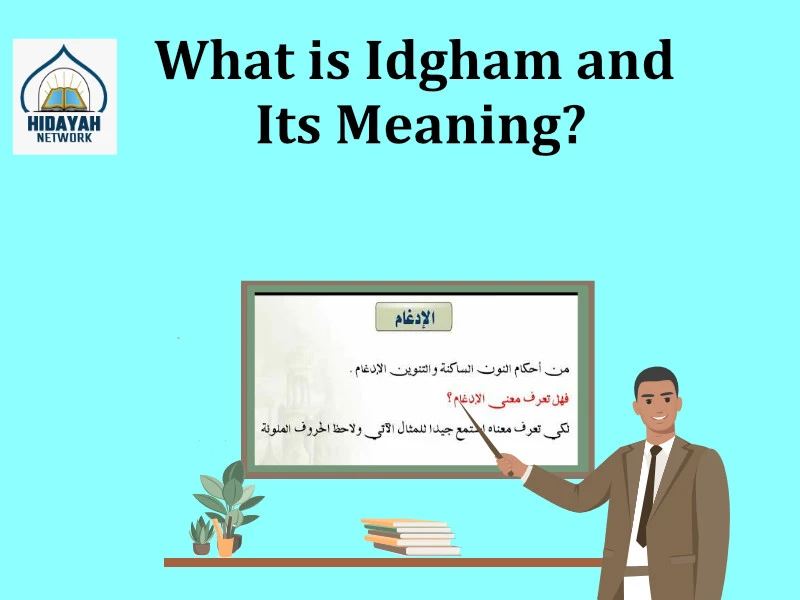Among many Tajweed rules, Idgham is a pivotal concept that simplifies Quranic reading. Idgham creates a harmonious flow, avoiding abrupt disruptions in the recitation, ultimately enhancing the beauty and clarity of Quranic verses. Here, we will learn about the significance of Idgham in Tajweed and explore its two primary types, shedding light on their practical applications.
Idgham, in the context of Tajweed, refers to the merging of two specific Arabic letters, namely, ‘ن’ (noon) and ‘م’ (meem), with the preceding letter. This merging Idgham can be categorized into two main types, representing distinct combinations of letters and sounds, each contributing to the eloquent and correct articulation of the Quran.
Table of Contents
ToggleWhat is Idgham and Its Meaning?

Idgham in Tajweed is like a special way of saying Arabic letters. It happens when we take two letters, “ن” (noon) and “م” (meem), and mix them with the letter before them. It’s like blending them smoothly to sound like one letter instead of two. This helps make the Quran sound beautiful and easy to read because the words have no awkward stops or breaks.
It’s super important in Tajweed rules because it ensures we recite the Quran correctly and melodiously, just as it was revealed to Prophet Muhammad, peace be upon him. The Quran is like a treasure, and Tajweed is the key to unlocking its beauty. Idgham is one of those keys. Without it, the Quran might not sound as lovely, and we might not read it as it was meant to be.
Get 40% OFF Now!
What are Idgham Letters?
The Idgham letters are specific Arabic letters that play a crucial role in Tajweed types by merging with the letter that comes before them during Quranic recitation. There are four primary Idgham letters in Tajweed: و (waw), م (meem), ن (noon), and ي (ya).
Let’s delve into the characteristics and significance of each of these letters.
و (Waw)
The letter “و” is pronounced like “w” in English. In Idgham, with “و,” it combines with the preceding letter, creating a harmonious transition. This merging is essential for the smooth flow of the Quranic text. When you encounter “و” in the Quran, you should connect it with the letter before it, allowing the words to flow seamlessly.
م (Meem)
The letter “م” is like the English “m” sound. In Idgham with “م,” it blends smoothly with the letter before it, preventing any disruptions in the recitation. Properly merging “م” ensures that the Quranic verses are recited melodiously and accurately.
ن (Noon)
“ن” is pronounced like “n” in English. In Idgham with “ن,” it fuses with the previous letter, promoting a graceful and uninterrupted recitation. Correctly implementing “ن” in Tajweed enhances the beauty of Quranic verses and maintains their proper pronunciation.
ي (Ya)
The letter “ي” sounds like the English “y.” When practicing Idgham with “ي,” it seamlessly merges with the preceding letter, creating a melodious and continuous recitation. This correct blending of “ي” is vital for the clarity and beauty of Quranic recitation.
Types of Idgham in Tajweed
1. Idgham with Ghunnah
This type of Idgham involves merging two specific letters while maintaining a short, nasal sound called “Ghunnah.” Ghunnah is produced by pronouncing the sound from the nose. The letters involved in this type of Idgham are the nasal sounds “م” (meem) and “ن” (noon) when they appear after a letter of “م” (meem) or “ن” (noon). The Ghunnah serves to add a melodious touch to the recitation.
In Surah Al-Ikhlas (Chapter 112), the word “الصَّمَدُ” is pronounced with Idgham with Ghunnah. The letter “م” in “صَّمَدُ” merges with the “ن” in “النَّاسِ,” creating a melodious blend while maintaining a slight nasal sound.
2. Idgham without Ghunnah
In this type of Idgham, letters merge without producing the nasal sound “Ghunnah.” It occurs when the letters “و” (waw) or “ي” (ya) are followed by “م” (meem) or “ن” (noon). The merging in Idgham without Ghunnah is smooth but lacks the nasal quality present in the first type.
In Surah Al-Qalam (Chapter 68), the word “أَوَ لَمْ يَرَوْا” features Idgham without Ghunnah. The letter “و” in “أَوَ” combines smoothly with the “م” in “لَمْ,” creating a harmonious transition without a Ghunnah sound.
Learn Idgham in Tajweed and Its Types with Tajweed Tutors
Mastering Tajweed, with its intricate rules like Idgham, is paramount for those seeking to enhance their understanding of Quranic recitation. It is essential to comprehend the nuances of Idgham with and without Ghunnah, as these distinctions significantly impact the melodious and accurate rendition of the Quran.
To embark on this enlightening journey, Hidayah Network stands as the best solution. Their advanced Tajweed courses help individuals learn Quran Tajweed and delve into the finer details of rules such as Idgham.
Final Words
Idgham is a fundamental concept in Tajweed, contributing significantly to the grace and accuracy of Quranic recitation. Understanding the two primary types, Idgham with Ghunnah and Idgham without Ghunnah, is crucial for those seeking to excel in Quranic recitation.
Mastering these principles allows individuals to read the Quran with a harmonious flow while preserving the correct pronunciation of Arabic letters.
Most Important FAQs
To write Idgham in Arabic, you don’t use a specific character for it. Instead, it’s a rule of Tajweed that involves merging two specific Arabic letters with the letter that comes before them, such as ‘ن’ (noon) or ‘م’ (meem) with the preceding letter.
The exceptions to Idgham include when ‘ن’ (noon) or ‘م’ (meem) are followed by specific letters like ‘ب’ (ba), ‘ج’ (jeem), ‘ح’ (ha), ‘ع’ (ain), ‘ه’ (ha), and ‘غ’ (ghain). In these cases, there is no Idgham.
Examples of Idghaam Noon Saakin include “النَّبِيُّ” where ‘ن’ and ‘ب’ merge smoothly without a pause, creating a nasal sound, and “الْعَلِيمُ” where ‘م’ and ‘ل’ blend without interruption.
Idgham Shafawi is a type of Idgham where ‘ش’ (sheen) merges with ‘ف’ (fa). An example can be found in the Quran in Surah Al-Haaqqa (Chapter 69) in the word “شَفِيعًا,” where ‘ش’ and ‘ف’ are blended smoothly to enhance recitation.

About Author

